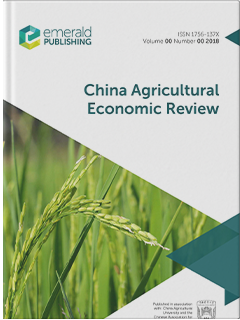环境调控与畜牧业区位动态——来自279个地级市的证据
IF 4.6
2区 经济学
Q1 AGRICULTURAL ECONOMICS & POLICY
引用次数: 3
摘要
目的研究畜牧业环境法规(LERs)对畜牧业区位动态的影响。具体来说,它检验了中国畜牧业是否存在“污染避风港效应”。设计/方法/方法基于2010 - 2017年279个地级市政府工作报告中畜牧相关词汇的频率,作者手工收集了LERs数据。以中国自2014年以来实施的LERs作为自然实验,作者采用差分中差(DID)来避免内生性问题。研究发现,slers导致受管制地区的牲畜产量下降。此外,相对于严格约束的地区(南方和发达地区),严格约束的地区(北方和欠发达地区)吸引了更多的畜牧业。因此,中国北方和欠发达地区的人们面临着更严重的牲畜污染。首先,大多数关于PHE的实证研究集中在工业企业。畜牧业中的PHE受到的关注有限。本文旨在填补这一空白。其次,本文将LERs视为一个内生过程,并使用DID方法生成无偏结果。第三,本文介绍了一种基于地级市政府工作报告中畜牧相关词汇频率的ler测量方法。第四,本文采用地级数据对城乡居民健康状况进行分析,得出更可靠的结果。本文章由计算机程序翻译,如有差异,请以英文原文为准。
Environmental regulation and location dynamics of the livestock industry: evidence from 279 Chinese prefecture-level cities
PurposeThis paper examines the impact of livestock environment regulations (LERs) on the location dynamics of the livestock farming industry. Specifically, it tests whether a “pollution haven effect” (PHE) exists in the Chinese livestock industry.Design/methodology/approachThe authors manually collected LERs data based on the frequency of livestock-related vocabulary in government work reports from 279 prefecture-level cities from 2010 to 2017. Using China's implementation of LERs since 2014 as a natural experiment, the authors employed difference-in-difference (DID) to avoid the endogeneity problem.FindingsLERs have led to a decline in livestock production in regulated areas. Moreover, compared with areas with more stringent LERs – southern China and developed areas, areas where LERs are less stringent – northern China and undeveloped areas, attract more livestock industry. As a result, people in northern China and undeveloped areas are exposed to higher livestock pollution.Originality/valueFirst, most empirical studies on PHE focus on industrial firms. PHE in the livestock industry has received limited attention. This paper aims to fill this gap. Second, this paper regards LERs as an endogenous process and uses the DID method to generate unbiased results. Third, this paper introduces a novel measurement of LERs based on the frequency of livestock-related vocabulary in government work reports from each prefecture city. Fourth, this paper uses prefecture-level data to analyze the PHE of LERs, and thus obtains more reliable results.
求助全文
通过发布文献求助,成功后即可免费获取论文全文。
去求助
来源期刊

China Agricultural Economic Review
AGRICULTURAL ECONOMICS & POLICY-
CiteScore
9.80
自引率
5.90%
发文量
41
审稿时长
>12 weeks
期刊介绍:
Published in association with China Agricultural University and the Chinese Association for Agricultural Economics, China Agricultural Economic Review publishes academic writings by international scholars, and particularly encourages empirical work that can be replicated and extended by others; and research articles that employ econometric and statistical hypothesis testing, optimization and simulation models. The journal aims to publish research which can be applied to China’s agricultural and rural policy-making process, the development of the agricultural economics discipline and to developing countries hoping to learn from China’s agricultural and rural development.
 求助内容:
求助内容: 应助结果提醒方式:
应助结果提醒方式:


